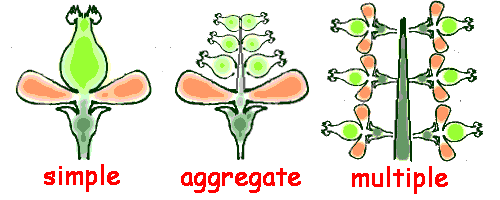
sepals
A modified leaf in angiosperms that helps enclose and protect a flower bud before it opens.

petals
A modified leaf of a flowering plant. Petals are the often colorful parts of a flower that advertise it to insects and other pollinators.

stamens
The pollen-producing reproductive organ of a flower, consisting of an anther and a filament.

carpels
The ovule-producing reproductive organ of a flower, consisting of the stigma, style, and ovary.

receptacle
The base of a flower; the part of the stem that is the site of attachment of the floral organs.

anther
In an angiosperm, the terminal pollen sac of a stamen, where pollen grains containing sperm-producing male gametophytes form.

ovary
In flowers, the portion of a carpel in which the egg-containing ovules develop.

style
The stalk of a flower’s carpel, with the ovary at the base and the stigma at the top.

stigma
The sticky part of a flower’s carpel, which receives pollen grains.

ovules
A structure that develops within the ovary of a seed plant and contains the female gametophyte.

pistil
A single carpel or a group of fused carpels.
complete flowers
A flower that has all four basic floral organs: sepals, petals, stamens, and carpels.
incomplete flowers
A flower in which one or more of the four basic floral organs (sepals, petals, stamens, or carpels) are either absent or nonfunctional.
.svg/240px-Dreifachdolde_(inflorescence).svg.png)
inflorescences
A group of flowers tightly clustered together.
microspores
A spore from a heterosporous plant species that develops into a male gametophyte.
pollen grain
In seed plants, a structure consisting of the male gametophyte enclosed within a pollen wall.
pollen tube
A tube that forms after germination of the pollen grain and that functions in the delivery of sperm to the ovule.
embryo sac
The female gametophyte of angiosperms, formed from the growth and division of the megaspore into a multicellular structure that typically has eight haploid nuclei.
megaspores
A spore from a heterosporous plant species that develops into a female gametophyte.
pollination
The transfer of pollen to the part of a seed plant containing the ovules, a process required for fertilization.
coevolution
The joint evolution of two interacting species, each in response to selection imposed by the other.

endosperm
In angiosperms, a nutrient-rich tissue formed by the union of a sperm with two polar nuclei during double fertilization. The endosperm provides nourishment to the developing embryo in angiosperm seeds.

double fertilization
A mechanism of fertilization in angiosperms in which two sperm cells unite with two cells in the female gametophyte (embryo sac) to form the zygote and endosperm.
dormancy
A condition typified by extremely low metabolic rate and a suspension of growth and development.

seed coat
A tough outer covering of a seed, formed from the outer coat of an ovule. In a flowering plant, the seed coat encloses and protects the embryo and endosperm.

hypocotyl
In an angiosperm embryo, the embryonic axis below the point of attachment of the cotyledon(s) and above the radicle.

radicle
An embryonic root of a plant.

epicotyl
In an angiosperm embryo, the embryonic axis above the point of attachment of the cotyledon(s) and below the first pair of miniature leaves.

coleoptile
The covering of the young shoot of the embryo of a grass seed.

coleorhiza
The covering of the young root of the embryo of a grass seed.
imbibition
The physical adsorption of water onto the internal surfaces of structures.
fruit
A mature ovary of a flower. The fruit protects dormant seeds and often aids in their dispersal.

simple fruits
A fruit derived from a single carpel or several fused carpels.

aggregate fruit
A fruit derived from a single flower that has more than one carpel.

multiple fruit
A fruit derived from an entire inflorescence.
accessory fruit
A fruit, or assemblage of fruits, in which the fleshy parts are derived largely or entirely from tissues other than the ovary.
fragmentation
A means of asexual reproduction whereby a single parent breaks into parts that regenerate into whole new individuals.
apomixis
The ability of some plant species to reproduce asexually through seeds without fertilization by a male gamete.
vegetative reproduction
Cloning of plants by asexual means.
dioecious
In plant biology, having the male and female reproductive parts on different individuals of the same species.
self-incompatability
The ability of a seed plant to reject its own pollen and sometimes the pollen of closely related individuals.
callus
A mass of dividing, undifferentiated cells growing in culture.
stock
The plant that provides the root system when making a graft.
scion
The twig grafted onto the stock when making a graft.
transgenic
Pertaining to an organism whose genome contains a gene introduced from another organism of the same or a different species.
protoplast fusion
The fusing of two protoplasts from different plant species that would otherwise be reproductively incompatible.
biofuels
A fuel produced from dry organic matter or combustible oils produced by plants.